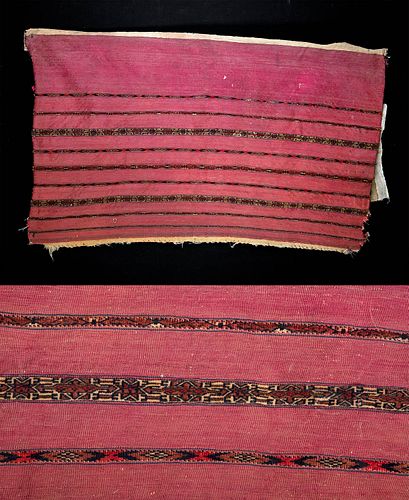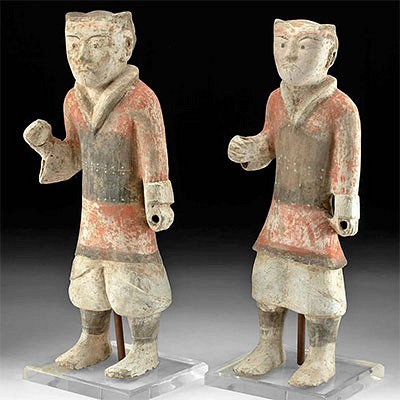19th C. Turkoman Tekke Wool Textile Carpet Panel / Bag
Lot 49a
About Seller
Artemis Fine Arts
686 S Taylor Ave, Ste 106
Louisville, CO 80027
United States
Selling antiquities, ancient and ethnographic art online since 1993, Artemis Gallery specializes in Classical Antiquities (Egyptian, Greek, Roman, Near Eastern), Asian, Pre-Columbian, African / Tribal / Oceanographic art. Our extensive inventory includes pottery, stone, metal, wood, glass and textil...Read more
Categories
Estimate:
$1,100 - $1,650
Absentee vs Live bid
Two ways to bid:
- Leave a max absentee bid and the platform will bid on your behalf up to your maximum bid during the live auction.
- Bid live during the auction and your bids will be submitted real-time to the auctioneer.
Bid Increments
| Price | Bid Increment |
|---|---|
| $0 | $25 |
| $300 | $50 |
| $1,000 | $100 |
| $2,000 | $250 |
| $5,000 | $500 |
| $10,000 | $1,000 |
| $20,000 | $2,500 |
| $50,000 | $5,000 |
| $100,000 | $10,000 |
| $200,000 | $20,000 |
About Auction
By Artemis Fine Arts
May 25, 2023
Set Reminder
2023-05-25 10:00:00
2023-05-25 10:00:00
America/New_York
Bidsquare
Bidsquare : ON-SALE! Antiquities, Pre-Columbian, Ethno, Fine Art
https://www.bidsquare.com/auctions/artemis-gallery/on-sale-antiquities-pre-columbian-ethno-fine-art-12860
ON-SALE Antiquities, Pre-Columbian, Ethno, More! Artemis Fine Arts info@artemisfinearts.com
ON-SALE Antiquities, Pre-Columbian, Ethno, More! Artemis Fine Arts info@artemisfinearts.com
- Lot Description
Central Asia, Turkmenistan, Turkoman (Turkman) Tekke people, ca. late 19th century CE. A beautiful woven and knotted wool pile textile presenting traditional motifs in a striking color palette of russet red, black, beige deep maroon brown on one half, then folded and sewn to the rest of the plain brown panel. This woven rectangular pocket-like shape may have been intended to use as a large storage bag known as an ak-chuval. The horizontal geometric registers on central field are known as guls and function as tribal emblems. The Tekke are a nomadic Turkmen tribe, the ak-chuval is traditionally handwoven by women using wool from their herds of sheep or goats, and these massive bags contained their possessions while traveling. This is a beautiful example that showcases their remarkable weaving skills and traditional patterns! Size: 57" L x 34" W (144.8 cm x 86.4 cm)
This piece was owned by Peggy Slappey, a renowned collector of Uzbek art. Her collection was featured at the Birmingham Museum of Art (March 19th, 2016 to July 10th, 2016) for an exhibition on Uzbek ikat textiles.
Provenance: private Dunwoody, Georgia, USA collection; ex-Peggy Slappey collection
All items legal to buy/sell under U.S. Statute covering cultural patrimony Code 2600, CHAPTER 14, and are guaranteed to be as described or your money back.
A Certificate of Authenticity will accompany all winning bids.
We ship worldwide and handle all shipping in-house for your convenience.
#164660Fair condition. Losses to weaving on red ground in corner as show. Fraying and losses to stitches holding the edges together. Punctures and fraying throughout. Staining and discoloration. Woven motifs are preserved for the most part.Condition
- Shipping Info
-
All shipping is handled in-house for your convenience. Your invoice from Artemis Gallery will include shipping calculation instructions. If in doubt, please inquire BEFORE bidding for estimated shipping costs for individual items.
-
- Buyer's Premium



 EUR
EUR CAD
CAD AUD
AUD GBP
GBP MXN
MXN HKD
HKD CNY
CNY MYR
MYR SEK
SEK SGD
SGD CHF
CHF THB
THB














